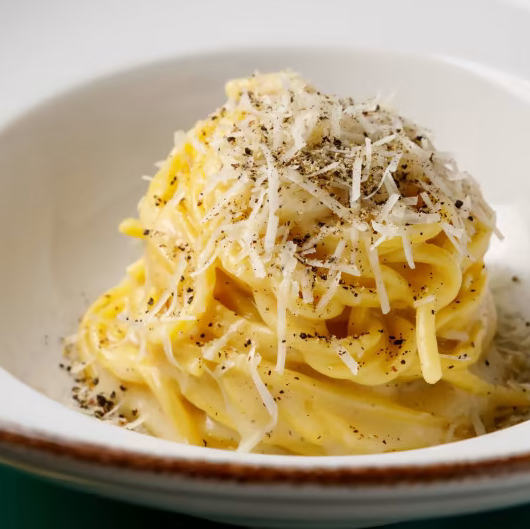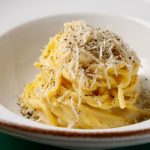
Luciano's Foolproof Cacio e Pepe
Luciano Monosillio's restaurant-style foolproof technique for making cacio e pepe.
Chef Luciano Monosillio
Restaurant Luciano Cucina Italiana
Cuisine Italian
Servings 2
Ingredients
- 120 g Pecorino Romano Freshly Grated
- 150 g Grana Padano Freshly Grated
- 6 g Toasted Whole Sarawak or Whole Tellicherry Peppercorns
- 240 g Tonnarelli, Lombrichelli, or Pici*
- 20 g Extra Virgin Olive Oil
- 5 g (2 tsp) Corn Starch
- 50 ml Pasta Water
Instructions
- Dry-roast the black peppercorns in a small frying pan over low heat, swirling until very fragrant (approximately 4–5 minutes). Cool then coarsely grind, preferably with a mortar and pestle, and set aside 2 g of the ground pepper.
- Put 180 ml (¾ cup) cold water into a sauce pan and add the cornstarch. Stir then heat and bring to a boil. Remove from heat and cool.
- In a blender add both cheeses and mix well. Add the 2g of grated pepper and mix. Slowly drizzle in the extra virgin olive oil while blending and then slowly blend in 50 ml of the cooled cornstarch mixture. Blend until the sauce is homogenous and creamy.**
- Using a medium pot, heat the water to a rolling boil and then lightly salt. (In order to concentrate the starch in the pasta water, and facilitate sauce emulsification, do not use a large pot or too much water)
- Once the water is boiling, add the pasta and cook for the indicated time. While the pasta cooks, warm the serving dishes in the oven.
- Drain the cooked pasta and place it into a bowl, reserving the pasta water.
- In a cold pan, place 2 spoonfuls of the cacio e pepe sauce concentrate and 1 ladleful of pasta water, stir to combine.
- Once homogeneous, add the pasta and mix vigorously. Add another ladleful of pasta water and turn on the heat to low. Toss the pasta continuously, not letting it become too dry.
- Dust with additional ground pepper and mix.
- Plate on the warm serving dishes and garnish with grated pecorino Romano and ground pepper.
Notes
*Use fresh soft wheat (i.e. lombrichelli or pici) or fresh egg and semolina (i.e. tonnarelli) pastas when possible for cacio e pepe. If substituting with dried pasta, use dried pici, spaghettoni, or bucatini.
**If desired, the cacio e pepe sauce can be frozen for later use after this step.
Avoid pre-grated pecorino that contains cellulose as it can inhibit emulsification.
Vigorous tossing is essential for achieving an emulsified sauce, or mantecatura.
Here, approximately 6 g of whole peppercorns are used to account for moisture loss during toasting and grinding, yielding at least 2 g of ground pepper for incorporation, plus additional for garnish. Since Tellicherry pepper is bolder than Sarawak, adjust the amount of pepper to taste.
Warming of the serving dishes is important to maintain the consistency of the sauce.
Watch Luciano Monosillio prepare this recipe.
For Sara Cicolini's equally delicious and more traditionally prepared spaghettoni con cacio e pepe served at SantoPalato, see her recipe and watch her prepare it. For Leonardo Vignoli's classic cacio e pepe served at Cesare al Casaletto, see his recipe here.
For a rough guide to the four essential Roman pastas—cacio e pepe, gricia, carbonara, and amatriciana—see this chart.

